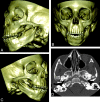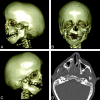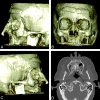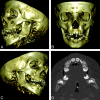Syndromes of the first and second branchial arches, part 2: syndromes
- PMID: 20360348
- PMCID: PMC7965699
- DOI: 10.3174/ajnr.A2073
Syndromes of the first and second branchial arches, part 2: syndromes
Abstract
A variety of congenital syndromes affecting the face occur due to defects involving the first and second BAs. Radiographic evaluation of craniofacial deformities is necessary to define aberrant anatomy, plan surgical procedures, and evaluate the effects of craniofacial growth and surgical reconstructions. High-resolution CT has proved vital in determining the nature and extent of these syndromes. The radiologic evaluation of syndromes of the first and second BA should begin first by studying a series of isolated defects (cleft lip with or without CP, micrognathia, and EAC atresia) that compose the major features of these syndromes and allow a more specific diagnosis. After discussion of these defects and the associated embryology, we discuss PRS, HFM, ACS, TCS, Stickler syndrome, and VCFS.
Figures







Similar articles
-
Syndromes of the first and second branchial arches, part 1: embryology and characteristic defects.AJNR Am J Neuroradiol. 2011 Jan;32(1):14-9. doi: 10.3174/ajnr.A2072. Epub 2010 Mar 18. AJNR Am J Neuroradiol. 2011. PMID: 20299437 Free PMC article. Review.
-
First and second branchial arch syndromes: multimodality approach.Pediatr Radiol. 2011 May;41(5):549-61. doi: 10.1007/s00247-010-1831-3. Epub 2010 Oct 6. Pediatr Radiol. 2011. PMID: 20924574 Review.
-
[Facial malformations and asymmetries due to first and second branchial arch syndromes].Acta Stomatol Belg. 1989 Jun;86(1):49-65. Acta Stomatol Belg. 1989. PMID: 2577742 Dutch.
-
Imaging of the Fetal Zygomatic Bone: A Key Role in Prenatal Diagnosis of First Branchial Arch Syndrome.J Ultrasound Med. 2020 Nov;39(11):2165-2172. doi: 10.1002/jum.15325. Epub 2020 May 7. J Ultrasound Med. 2020. PMID: 32378755
-
Teratological studies on craniofacial malformations.Swed Dent J Suppl. 1997;121:3-84. Swed Dent J Suppl. 1997. PMID: 9200351
Cited by
-
Prenatal diagnosis of treacher-collins syndrome using three-dimensional ultrasonography and differential diagnosis with other acrofacial dysostosis syndromes.Case Rep Obstet Gynecol. 2013;2013:203976. doi: 10.1155/2013/203976. Epub 2013 Apr 4. Case Rep Obstet Gynecol. 2013. PMID: 23653874 Free PMC article.
-
Clinical manifestations and treatment strategies for congenital aural atresia with temporomandibular joint retroposition: a retrospective study of 30 patients.J Otolaryngol Head Neck Surg. 2023 Mar 8;52(1):24. doi: 10.1186/s40463-022-00615-4. J Otolaryngol Head Neck Surg. 2023. PMID: 36882877 Free PMC article.
-
Chromosomal microarray analysis in the prenatal diagnosis of orofacial clefts: Experience from a single medical center in mainland China.Medicine (Baltimore). 2018 Aug;97(34):e12057. doi: 10.1097/MD.0000000000012057. Medicine (Baltimore). 2018. PMID: 30142861 Free PMC article.
-
Elongation factor 1 alpha1 and genes associated with Usher syndromes are downstream targets of GBX2.PLoS One. 2012;7(11):e47366. doi: 10.1371/journal.pone.0047366. Epub 2012 Nov 8. PLoS One. 2012. PMID: 23144817 Free PMC article.
-
Imaging neonates and children with Pierre Robin sequence before and after mandibular distraction osteogenesis: what the craniofacial surgeon wants to know.Pediatr Radiol. 2015 Aug;45(9):1392-402. doi: 10.1007/s00247-015-3323-y. Epub 2015 Mar 20. Pediatr Radiol. 2015. PMID: 25792154 Review.
References
-
- Marsh JL. Comprehensive Care for Craniofacial Deformities. St. Louis, Missouri: Mosby; 1985
-
- Robin P. La chute de la base de la langue consideree comme une nouvelle cause de gene dans la respiration nasopharyngienne. Bull Acad de Med 1923;89:37–41
-
- Robin P. La Glossoptose: Un Grave Danger Pour Nos Enfants. Paris, France: Gaston Doin; 1929
-
- Robin P. Glossoptosis due to atresia and hypotrophy of the mandible. Am J Dis Child 1934;48:541
-
- Figueroa AA, Glupker TJ, Fitz MG, et al. . Mandible, tongue, and airway in Pierre Robin sequence: a longitudinal cephalometric study. Cleft Palate Craniofac J 1991;28:425–34 - PubMed
Publication types
MeSH terms
Supplementary concepts
LinkOut - more resources
Full Text Sources
Medical
Miscellaneous
